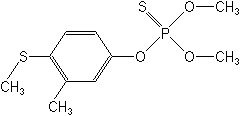-
Common NameFenthion
-
中文通用名倍硫磷
-
IUPACO,O-dimethyl O-4-methylthio-m-tolyl phosphorothioate
-
CASO,O-dimethyl O-[3-methyl-4-(methylthio)phenyl] phosphorothioate
-
CAS No.55-38-9
-
Molecular FormulaC10H15O3PS2
-
Molecular Structure
-
Category
-
ActivityInsecticide
-
Physical PropertiesMolecular weight:278.3; Physical form:Colourless, oily liquid; ( tech., brown, oily liquid, with a mercaptan-like odour). Density:1.25 (20 °C); Melting point:No solidification point down to -80 °C; Flash point:170 °C ( tech.); Vapour pressure:0.74 mPa (20 °C); 1.4 mPa (25 °C); Henry constant:5 × 10-2 Pa m3 mol-1 (20 °C); Partition coefficient(n-octanol and water):logP = 4.84; Solubility:In water 4.2 mg/l (20 °C). In dichloromethane, toluene, isopropanol >250, hexane 100 (all in g/l, 20 °C).; Stability:Stable to ligh,t and up to 210 °C. Relatively stable in acidic conditions, and moderately stable in alkaline conditions; DT50 (22 °C) 223 d ( pH 4), 200 d ( pH 7), 151 d ( pH 9).;
-
ToxicologyOral:Acute oral LD50 for male and female rats c. 250 mg/ kg. Percutaneous:Acute percutaneous LD50 (24 h) for male rats 586, female rats 800 mg/ kg; not irritating to skin and eyes (rabbits). Inhalation: LC50 (4 h) for male and female rats c. 0.5 mg/l air (aerosol). Phytotoxicity:Non-phytotoxic when used as recommended. Some varieties of apples and cotton may be injured. ADI:( JMPR) 0.01 mg/ kg b.w. [1995].
-
Environmental ProfileEcotoxicology:
Algae: ErC50 for Scenedesmus subspicatus 1.79 mg/l.Bees:Toxic to bees.Birds:Acute oral LD50 for bobwhite quail 7.2 mg/kg. Dietary LC50 (5 d) for bobwhite quail 60, mallard ducks 1259 mg/ kg.Daphnia: LC50 (48 h) 0.0057 mg50 (96 h) for bluegill sunfish 1.7, rainbow trout 0.8-1.0, golden orfe 2.7 mg/l.Worms: LC50 for Eisenia foetida 375 mg/ kg dry soil.
Environmental fate:
Animals:In mammals, following oral administration, elimination is mainly in the form of hydrolysis products in the urine. Major metabolites are fenthion sulfoxide, fenthion sulfone and their oxygen analogues. These metabolites are hydrolysed in further degradatioSoil: Koc 1500 (Ware, Rev. Environ. Contam. Toxicol., 123 (1992)). In sediment/water system with and without plants, DT50 is c. 1.5 d (O'Neill et al.,Plant:In plants, fenthion is oxidised to the sulfoxide and sulfone, both of which possess insecticidal properties, and to the monodesmethyl compound of fenthion sulfoxide. Further degradation occurs to the sulfone phosphate, which undergoes hydrolysis. -
Transport InformationSignal Word:WARNING; Hazard Class:II(Moderately hazardous)
Porduct NewsMore
Fenthion use to cease in Australia from October 2015
Australia reconsiders fenthion registration

 0
0 Subscribe
Subscribe
